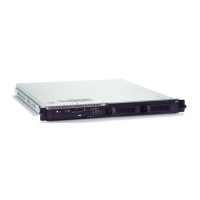released to internal server components when the server is powered-on might
cause the server to stop, which could result in the loss of data. To avoid this
potential problem, always use an electrostatic-discharge wrist strap or other
grounding system when working inside the server with the power on.
Attention: Static electricity that is released to internal server components when
the server is powered-on might cause the server to stop, which could result in
the loss of data. To avoid this potential problem, always use an
electrostatic-discharge wrist strap or other grounding system when working
inside the server with the power on.
v The specifications of a DDR3 DIMM are on a label on the DIMM, in the
following format.
ggg eRxff-PC3-wwwwwm-aa-bb-cc
where:
– ggg is the total capacity of the DIMM (for example, 1GB, 2GB, or 4GB)
– e is the number of ranks
- 1 = single-rank
- 2 = dual-rank
- 4 = quad-rank
– ff is the device organization (bit width)
- 4 = x4 organization (4 DQ lines per SDRAM)
- 8 = x8 organization
- 16 = x16 organization
– wwwww is the DIMM bandwidth, in MBps
- 8500 = 8.53 GBps (PC3-1066 SDRAMs, 8-byte primary data bus)
- 10600 = 10.66 GBps (PC3-1333 SDRAMs, 8-byte primary data bus)
- 12800 = 12.8 GBps (PC3-1600 SDRAMs, 8-byte primary data bus)
– m is the DIMM type
- E = Unbuffered DIMM (UDIMM) with ECC (x72-bit module data bus)
- R = Registered DIMM (RDIMM)
- U = Unbuffered DIMM with no ECC (x64-bit primary data bus)
– aa is the CAS latency, in clocks at maximum operating frequency
– bb is the JEDEC SPD Revision Encoding and Additions level
– cc is the reference design file for the design of the DIMM
– d is the revision number of the reference design of the DIMM
Note: To determine the type of a DIMM, see the label on the DIMM. The
information on the label is in the format xxxxx nRxxx PC3-xxxxx-xx-xx-xxx. The
numeral in the sixth numerical position indicates whether the DIMM is
single-rank (n=1) or dual-rank (n=2).
Chapter 6. Removing and replacing components 275

